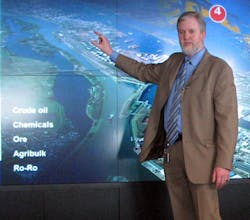Sometimes it's easy to get caught up thinking that port security has to do with worker access control and long-range thermal cameras to spot threats. Sometimes, it's more about compliance with the IMO (International Maritime Organization) and dealing with public safety issues like fires and toxic spills in the case of chemical facilities attached to port shipping operations.
Today, as part of a trip to Holland hosted by the Netherlands Foreign Investment Agency, I spent many hours in and around the Port of Rotterdam. For those of you who aren't familiar with Europe's shipping business, all you really need to know is that the Port of Rotterdam is Europe's largest and busiest port. It deals with roughly 12 million cargo containers in a years time, which is just part of an estimated 400 million tons of goods which come through the port in a year's time. The port allows easy distribution to all parts of Europe, using ground-based transportation, for imported goods which arrive at its docks.
When they say this is a big port, they mean it. As evidence in the photo above, the port extends 32 miles along the banks of a river which drains Switzerland, and it has many, many additional and parallel waterways. To ride a fairly quick boat (not a speedboat, mind you) from port headquarters to some of the outlying docks and facilities will take you well over an hour each way. That spread of the port, plus the high number of operators, vessels (sometimes a thousand docked here in a day's time), workers and materials arriving and departing make for one heck of a port security headache, but the Dutch seem to be handling the challenge well.
So, here are seven things they've done that are admirable:
1. Chief Harbormaster J.C. Lems (pictured above) is the de facto security chief, and thereby has to comply with maritime security regulations. Much of that also means setting his own strict security policies for the port, ranging from banning jetskis to requiring arriving vessels contact the port authority office at least one day before arrival.
2. Tracking and analyzing all vessels. The massive screens at the Port of Rotterdam Command and Control center identify the type of vessel, whether it's docked or en route, whether it has materials that would be considered hazardous or suspicious, and even whether a certified pilot is aboard the vessel. A close up (photo above) shows how different colors and symbols reflect different ship statuses and cargo risks.
3. They've developed one hell of a fire-fighting solution for everyone in the port environment -- from ships to facilities. The Gezarmenlijke Brandweer Unified Fire Department has unbelievable equipment and skills. It's a public/private partnership for fire protection services, paid for mainly by companies doing business at the port, but also by the government. The unified team -- which originally brought together 42 separate industrial fire brigades when it was founded in 1998 -- is well-practiced, having to deal with approximately 600 fires per year. One of the GB Unified Fire Department's core strengths is that it can successfully fight fires at the massive land-based chemical/oil storage tanks that surround the port. According to Dr. Ben M.G. Janssen, this capability is unique among the world's fire departments (but the equipment to do so is also incredibly expensive!).
4. Implementing an X-ray based cargo container screening system that can scan up to 150 containers an hour. Of course, it takes longer to analyze those scans, but the time is implied to be less than the current time requirement of 10-15 minutes per analysis. That helps spot things inside these metal containers, and identifies which suspicious containers need an actual "open-the-doors" hand inspection. Containers would be scanned individually based on risk levels after being unloaded from ocean going ships (photo above).
5. Planning for a future where they'll be tracking not just vessels, but the cargo. "In the future, we want to know exactly where the cargo is, how much there is, and how risky it is," explains Rotterdam area fire department's Chief of Safety and Operations Sjaak Seen (pictured). He notes that the city of Rotterdam is closely integrated with port operations. Indeed, you will see sea-going vessels pass through locks just a stone's throw from some of the city's better known parks and restaurants.
6. Innovative training. One of the things that port security and fire units have done is use technology from VSTEP, a Rotterdam-based company that developed a video game style of incident training (pictured is the company's CTO Pjotr van Schothorst). The games look like port version of Halo 3, with explosions blasting from tanker vessels. Unlike the trigger-happy versions of games on your PlayStation, however, these games teach incident control, communications and collaboration. They're even rolling out a multi-player version this year so you can put the head of security at one controller and the head of fire at another and the harbor master's team at another and get real-time interaction. Best of all, if the team is doing too well at one exercise, the instructor can easily toss in an additional event into th mix, like a simulated terrorist attack, to raise stress levels and broaden response needs.
7. Unifying everyone for an emergency. The Port Authority links with customs, port police, mayors of towns around the port, the regional fire department, the port's unified fire department, company representatives and other important officials in the case of an incident. A well-planned emergency strategy center features video and audio conferencing and space for key emergency management representatives. Data from the Port Authority's command center (pictured) is also linked to the port police force (the guys with the guns for when heavy-duty enforcement is needed).
All photos (c) 2009 by Geoff Kohl
About the Author

Geoff Kohl
Editorial Director/Editor-in-Chief/Associate Publisher
Geoff Kohl is the Marketing Director for the Security Industry Association (SIA). He is the former Editor-in-Chief of SecurityInfoWatch.com








